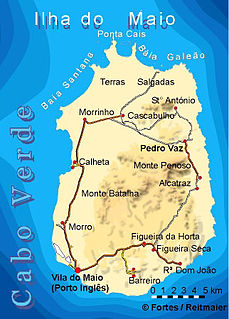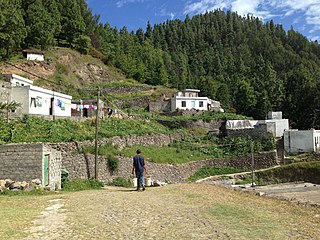| Praia Gonçalo | |
|---|---|
| Coordinates: 15°16′01″N23°06′50″W / 15.267°N 23.114°W Coordinates: 15°16′01″N23°06′50″W / 15.267°N 23.114°W | |
| Country | Cape Verde |
| Island | Maio |
| Municipality | Maio |
| Civil parish | Nossa Senhora da Luz |
| Population (2010) [1] | |
| • Total | 67 |
Praia Gonçalo is a settlement in the northeast of the island of Maio in Cape Verde. It 2010 population was 67. It is located 18 km northeast of the island capital Porto Inglês. It is also a beach covering the northeast of the island.

Maio is the easternmost of the Sotavento islands of Cape Verde. Maio is located south of the island of Boa Vista and east of Santiago. Administratively, the island forms one concelho (municipality): Maio.

Cape Verde or Cabo Verde, officially the Republic of Cabo Verde, is an island country spanning an archipelago of 10 volcanic islands in the central Atlantic Ocean. It forms part of the Macaronesia ecoregion, along with the Azores, Canary Islands, Madeira, and the Savage Isles. In ancient times these islands were referred to as "the Islands of the Blessed" or the "Fortunate Isles". Located 570 kilometres (350 mi) west of the Cape Verde Peninsula off the coast of Northwest Africa, the islands cover a combined area of slightly over 4,000 square kilometres (1,500 sq mi).

Porto Inglês is a city in the southwestern part of the island of Maio in southeastern Cape Verde. It is the main urban settlement of the island, and also seat of the Maio Municipality. Its population was 2,971 in 2010. The name Porto Inglês refers to English ships that exported salt produced on the island of Maio from this town. Salt exploitation continued until the 19th century. The inconclusive Battle of Maio was fought between British and French frigate squadrons close to the town on 23 January 1814 in the last stages of the Napoleonic Wars.
Contents
It is connected as a branch road with the Barreiro-Cascabulho Road, the East Maio Route.

Barreiro is a town in the southern part of the island of Maio, Cape Verde. It is around 5 km east of the island capital Porto Inglês. At the 2010 census, its population was 535.

Cascabulho is a village in the northern part of the island of Maio in Cape Verde. In 2010 its population was 204. It is located 15 km northeast of the island capital Porto Inglês. Further north is the nature reserve Terras Salgadas.
The beach would be first named as "Praya Gonçalo" along with the settlement later, which was the Middle Portuguese name used up to the 1911 Orthography Reform made by Portugal which removed the y and became replaced with an i. [2] , but in Cape Verdean Creole, the older form continued to be used up to the mid-20th century and continued in Maio Creole.
Maio Creole is the name given to the variant of Cape Verdean Creole spoken mainly in the Maio Island of Cape Verde. It belongs to the Sotavento Creoles branch. It numbers the entire island population which includes a small part which also speaks Portuguese, in 2005, the percentage was 1.36%.






